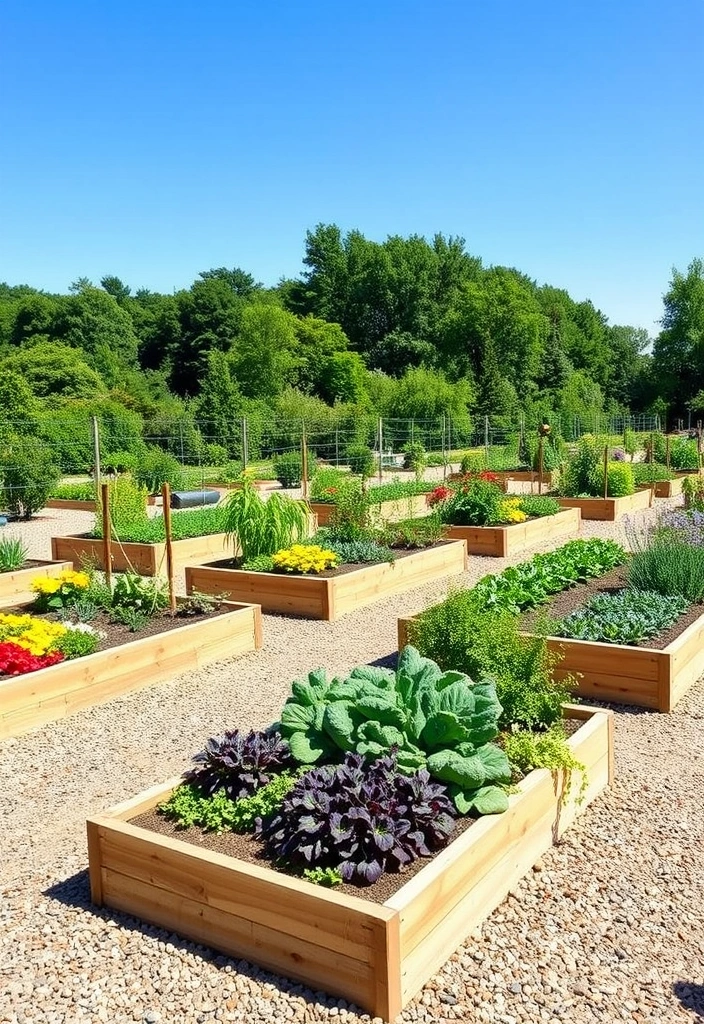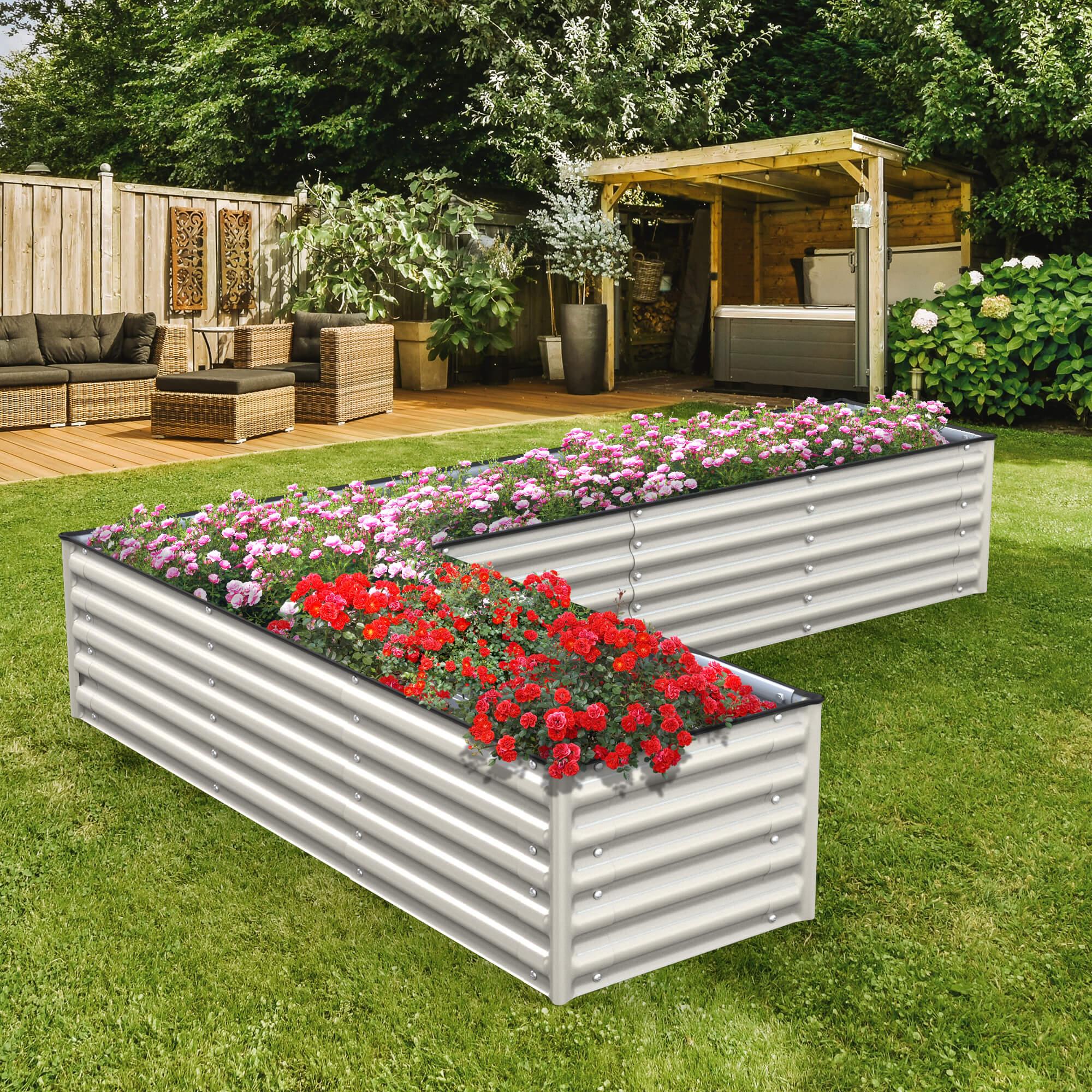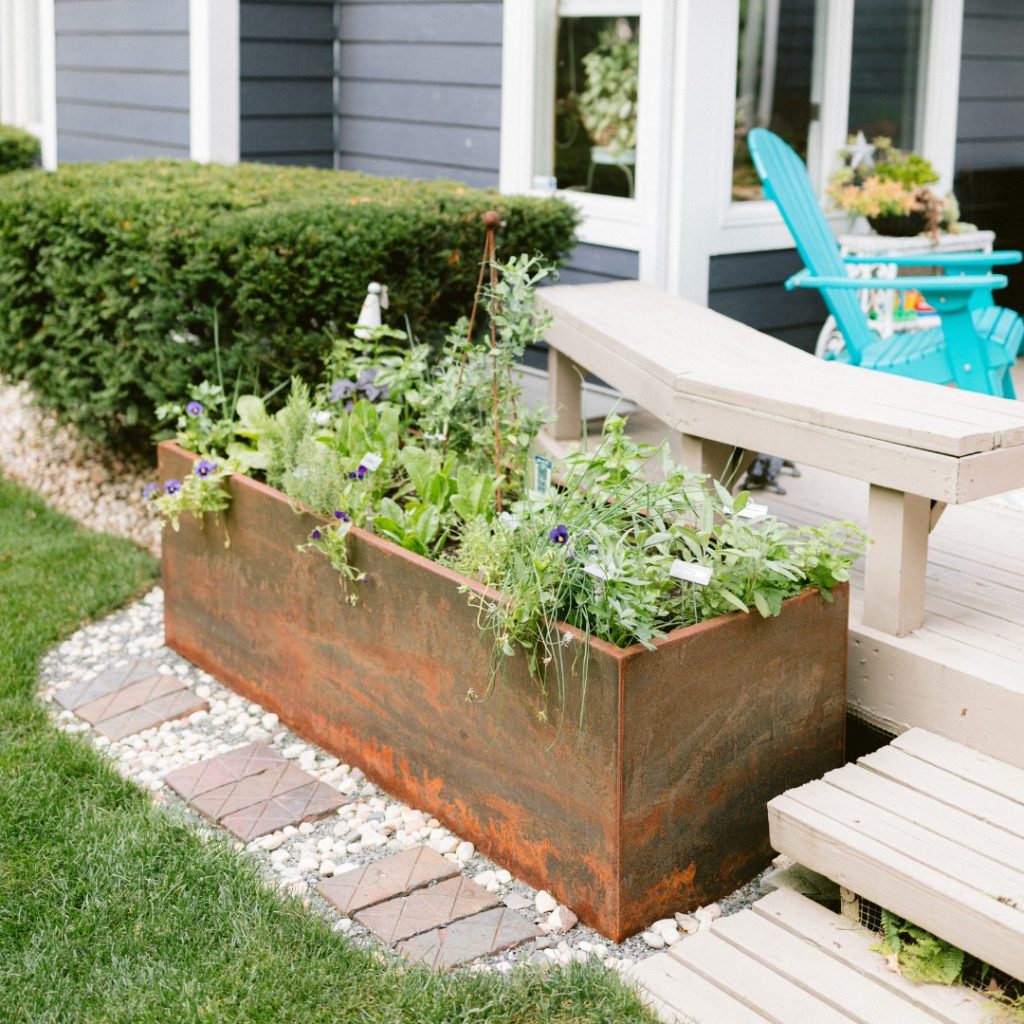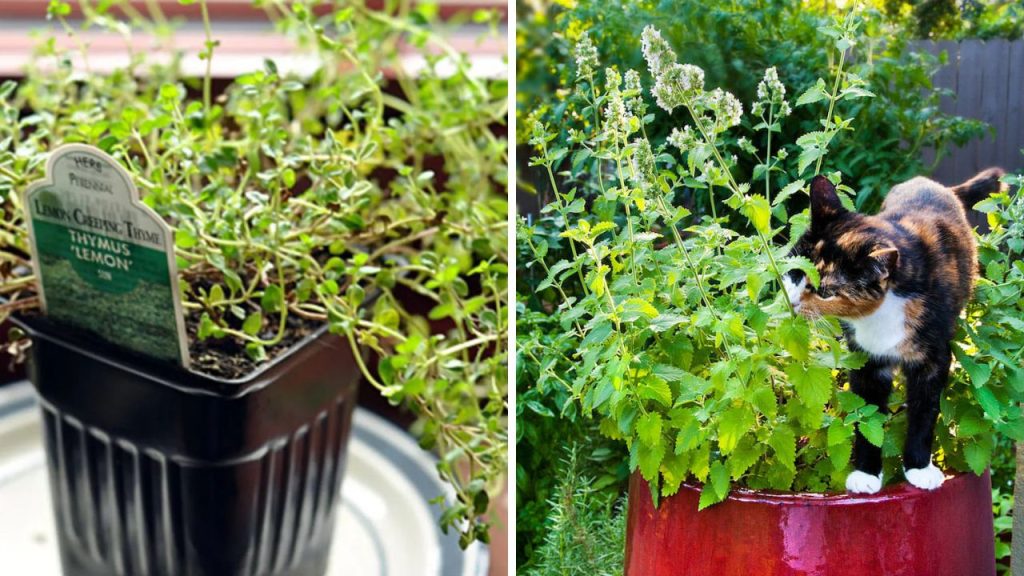Creating a raised garden bed can transform your outdoor space, making it not only more functional but also more aesthetically pleasing. Whether you’re a seasoned gardener or just starting, the layout of your raised garden beds can have a significant impact on your gardening experience. In this article, we’ll explore over 13 unique raised garden bed layout ideas that cater to various styles, preferences, and available space. Let’s dig in!
1. Classic Rectangular Layout

The classic rectangular layout is a favorite among gardeners for its simplicity and practicality. These beds are typically straightforward to construct and can be placed in a variety of locations, from sunny backyards to cozy patios. The rectangular shape allows for efficient use of space, making it easy to maximize your planting area.
When designing your rectangular raised bed, consider dimensions that suit your space and gardening needs. Common sizes range from 4 feet by 8 feet, which provides ample room for planting, to smaller versions like 2 feet by 4 feet for limited spaces. This versatility means you can customize the size to fit any area, whether you’re working with a sprawling backyard or a compact urban setting.
One of the key advantages of this layout is accessibility. The long, narrow shape allows you to reach the center of the bed from either side without stepping on the soil, which helps maintain soil structure and health. You can plant a variety of vegetables, herbs, and flowers in these beds, arranging them in rows or blocks to optimize sunlight exposure and growth.
Additionally, using a trellis or vertical supports on one side of a rectangular bed can add a creative touch while allowing climbing plants like peas and cucumbers to flourish. Incorporating companion planting—growing different plants together for mutual benefit—can also enhance your garden’s productivity and biodiversity. With a classic rectangular layout, you’re well on your way to a flourishing garden that looks as good as it grows!
2. L-Shaped Garden Beds

L-shaped garden beds are a fantastic option for maximizing corner spaces in your yard while adding a unique visual element to your garden design. This layout creates an inviting nook that can be both functional and aesthetically pleasing. L-shaped beds can be built to fit any corner or space in your yard, making them perfect for small gardens or patios.
The L-shape allows for easy access to all planting areas while providing ample room for planting various herbs, vegetables, and flowers. You can designate one side for taller plants, like sunflowers or tomatoes, while using the other for shorter herbs or ground cover. This method not only optimizes space but also creates a visually dynamic garden that is pleasing to the eye.
To enhance the functionality of your L-shaped garden bed, consider adding a seating area adjacent to it. This can provide a lovely spot for relaxation while you tend to your plants. Additionally, using decorative stones or bricks to outline the bed can elevate its look, providing a polished finish to your outdoor space.
When planning your planting layout, think about sunlight exposure and plant compatibility. Taller plants should be placed where they won’t shade shorter ones, ensuring that all plants receive adequate sunlight. L-shaped beds allow for creativity and personalization, enabling you to tailor your garden to reflect your style and preferences.
3. Circular Raised Beds

Circular raised beds are a striking alternative to traditional garden shapes, providing a unique focal point in your landscape. This layout not only maximizes planting space but also allows for easy access from all sides, making maintenance a breeze. Circular beds can be particularly beneficial in smaller gardens where every inch counts.
When constructing a circular raised bed, consider the size that best fits your space. A diameter of 4 to 6 feet is manageable for most gardeners, providing ample room for various plants while still being accessible. This shape allows you to plant a diverse array of flowers, herbs, and vegetables, creating a vibrant display.
One of the advantages of circular raised beds is the opportunity for creative planting. You can design the center with taller plants, such as sunflowers or ornamental grasses, and surround them with shorter plants like marigolds or lettuce. This layered effect not only looks stunning but also promotes healthy growth by utilizing vertical space.
To enhance the aesthetic appeal of your circular bed, consider incorporating decorative stones, mulch, or a mix of soil types. Adding pathways around the circular bed can also make it more accessible while providing a neat, organized appearance. Circular raised beds are perfect for those looking to add a unique twist to their gardening layout, making them a delightful addition to any outdoor space.
4. Tiered Raised Beds

Tiered raised beds are an innovative solution for gardeners working with sloped landscapes or limited space. This layout utilizes multiple levels, creating a cascading effect that is visually appealing while maximizing planting area. Tiered beds can be designed in various shapes and sizes, allowing for flexibility in your garden design.
Building tiered raised beds involves stacking sections of beds on top of one another, which not only saves space but also allows for better drainage and soil health. Each tier can be dedicated to different plants, with herbs and flowers at the top and more substantial vegetables at the bottom. This arrangement can enhance the visual impact of your garden, creating a stunning focal point.
When designing tiered beds, consider the height and width of each tier to ensure easy access for planting and maintenance. A height of 12 to 18 inches for each tier is typically manageable for most gardeners. Additionally, think about incorporating pathways between tiers to allow for easy movement and accessibility.
To further enhance your tiered raised beds, consider adding decorative elements such as rocks or plants that cascade over the edges. This can create a natural, flowing look that complements the tiered structure. Overall, tiered raised beds are an excellent choice for those looking to make the most of their garden space while adding a unique touch to their outdoor environment.
5. U-Shaped Garden Layout
Source
The U-shaped garden layout is perfect for those who want to create a cozy, enclosed gardening space. This design allows for easy access to all areas of the garden while providing ample planting space. U-shaped beds can be particularly effective in larger gardens, creating a central focal point that invites exploration.
In a U-shaped layout, the sides of the U can be designed to accommodate different types of plants, such as taller plants on the outer edges and smaller plants within the center. This arrangement not only optimizes space but also ensures that all plants receive adequate sunlight, contributing to healthier growth.
To enhance the U-shaped layout, consider adding a pathway through the center, allowing for easy access to all parts of the garden. This can be a simple dirt path, stepping stones, or even decorative gravel, depending on your style preferences. Incorporating a seating area at one end of the U can provide a perfect spot for relaxation and enjoyment of your garden.
When planning your U-shaped garden layout, consider the types of plants that will thrive in your climate and soil conditions. Mixing herbs, vegetables, and flowers can create a vibrant, diverse space that not only looks beautiful but also offers fresh produce at your fingertips. The U-shaped garden layout is ideal for those seeking a functional yet charming garden design.
6. Hexagonal Garden Beds
Source
Hexagonal garden beds are an eye-catching option that adds a modern twist to traditional garden designs. This unique shape not only maximizes space but also allows for an innovative planting layout. Hexagonal beds can be arranged in various configurations, making them suitable for gardens of all sizes.
One of the key benefits of hexagonal garden beds is their ability to create a visually striking pattern in your outdoor space. When arranged in clusters, hexagonal beds can form a beautiful honeycomb effect that enhances the overall design of your garden. This layout encourages creativity in plant selection and arrangement, allowing you to mix colors, heights, and textures.
When constructing hexagonal beds, consider the dimensions that will work best for your space. A standard size of 4 feet across can provide ample planting area while remaining manageable. These beds are perfect for growing a variety of plants, from vibrant flowers to delicious vegetables.
To further enhance the appeal of your hexagonal garden beds, consider incorporating pathways between them or using decorative edging to outline each bed. This can create a well-organized and visually appealing garden layout. Hexagonal garden beds are perfect for those looking to make a statement in their outdoor space while enjoying the benefits of a functional garden.
7. Pathway Between Beds
Source
Creating a pathway between raised garden beds is an excellent way to enhance the accessibility and organization of your garden. This layout not only allows for easy movement between planting areas but also adds a structured aesthetic that can elevate your outdoor space.
Pathways can be made from a variety of materials, including mulch, gravel, or pavers, allowing you to customize the look and feel of your garden. When designing your pathways, ensure they are wide enough for easy navigation, typically 2 to 3 feet, to accommodate wheelbarrows or garden carts.
This layout works particularly well in larger gardens, where multiple raised beds are arranged in a grid or linear pattern. By creating distinct pathways, you can separate different areas of your garden, making it easier to organize plants based on their needs, such as sun exposure and watering requirements.
Incorporating decorative elements along your pathways, such as stepping stones or small plants, can add charm and character to your garden. This layout not only enhances functionality but also creates an inviting atmosphere that encourages you to spend more time outdoors. With pathways between your raised beds, you can enjoy a well-organized, easily accessible garden that is both beautiful and productive.
8. Raised Bed Edging
Source
Adding edging to your raised garden beds is a simple yet effective way to enhance their structure and appearance. Edging not only helps to define the space but also prevents soil erosion and keeps weeds at bay. There are various materials you can use for edging, including wood, stone, metal, or even decorative bricks, allowing you to choose a style that complements your garden design.
When planning your raised bed edging, consider the height and thickness of the material. A height of 6 to 12 inches is often sufficient to keep soil contained while providing a visually appealing border. If you opt for wooden edging, ensure that the wood is treated for outdoor use to prevent rotting.
In addition to its functional benefits, raised bed edging can enhance the overall look of your garden. You can create a polished, finished appearance by using uniform materials, or go for a more rustic look with natural stones or reclaimed wood. Edging can also help to separate different garden areas, creating a structured layout that is both beautiful and practical.
Incorporating plants into the edging can add another layer of interest. Consider using low-growing herbs or flowers that spill over the edges for a charming effect. Raised bed edging is an excellent way to add character to your garden while maintaining organization and preventing soil loss.
9. Combination of Shapes
Source
Mixing different shapes of raised garden beds can create a dynamic and visually engaging garden layout. By incorporating various designs, such as rectangular, circular, and hexagonal beds, you can personalize your garden and create a unique landscape that reflects your style. This approach allows for creativity while maximizing the use of space.
When planning your combination layout, consider the overall flow of the garden. Position different shapes in a way that guides the eye through the space, creating a harmonious and inviting atmosphere. For instance, you could place a circular bed at the center, surrounded by rectangular beds, to create a focal point.
Using a mix of shapes can also enhance plant diversity, as different beds can accommodate various types of plants. Taller plants can be placed in the center or back of beds, while shorter plants can be situated in the front or outer edges, ensuring that each plant receives adequate sunlight.
To maintain cohesion in your mixed-shape layout, use similar materials or colors for your raised beds. This can create a unified look that ties the garden together, even with varying shapes. Combining different raised bed designs is a creative way to express your gardening style while maximizing the potential of your outdoor space.
10. Vertical Raised Beds
Source
Vertical raised beds are an innovative solution for gardeners with limited space or those looking to add an interesting design element to their garden. These beds utilize vertical space by incorporating shelves, trellises, or wall-mounted planters, allowing you to grow a variety of plants without taking up much ground space.
One of the main benefits of vertical raised beds is that they make gardening more accessible, especially for individuals with mobility challenges. By elevating the plants, you can reduce the need to bend down, making it easier to tend to your garden. This design is also ideal for growing climbing plants, such as beans, peas, and tomatoes, which can thrive when supported vertically.
When creating a vertical raised bed, consider using sturdy materials to ensure stability. Wooden frames or metal grids can provide a solid structure for your plants. You can also incorporate decorative elements, such as hanging pots or wall-mounted planters, to add visual interest to your vertical garden.
Additionally, think about the types of plants that work well in a vertical setup. Herbs, strawberries, and small vegetables are excellent choices for vertical raised beds. This layout allows you to maximize your growing potential while adding a unique design feature to your garden.
11. DIY Pallet Raised Beds
Source
Using pallets to create raised garden beds is a cost-effective and eco-friendly option for gardeners looking to save money while building their dream garden. This DIY approach allows you to repurpose old pallets into functional raised beds, adding character and charm to your outdoor space.
Building a pallet raised bed is relatively simple and can be completed with basic tools. Start by selecting sturdy pallets that are free from chemicals and damage. You can use one or more pallets to create the desired height and size for your bed. To enhance soil retention, line the bottom of the pallet with landscape fabric or cardboard before adding soil.
One of the advantages of pallet raised beds is their versatility. You can easily customize the size and shape to fit your garden space. These beds are perfect for growing herbs, flowers, or small vegetables, making them a great option for beginner gardeners.
To add a touch of personality, consider painting or staining the pallets to match your garden’s aesthetic. You can also plant flowers or herbs in the gaps of the pallets, creating a unique and visually appealing garden feature. DIY pallet raised beds are an excellent way to showcase your creativity while contributing to a sustainable gardening practice.
12. Raised Beds with Built-In Seating
Source
Incorporating built-in seating into your raised garden beds can create a functional and inviting outdoor space. This layout not only allows you to enjoy your garden but also provides a cozy area for relaxation and socializing with family and friends. Raised beds with seating can be designed in various shapes and styles, depending on your preferences and available space.
When designing your raised beds with built-in seating, consider the height and width of the seating area to ensure comfort. A height of 18 to 24 inches for seating is generally ideal, allowing for easy access to the garden while providing a comfortable spot to sit. You can use materials such as wood, stone, or composite decking for durability and aesthetics.
This layout encourages a connection with your garden, allowing you to take a break and enjoy the fruits of your labor. Consider positioning your seating area in a spot that offers a view of your garden, enhancing your outdoor experience.
In addition to seating, you can incorporate decorative elements like cushions or throw pillows to make the area more inviting. Built-in seating not only adds functionality to your garden but also creates a warm, welcoming atmosphere that invites relaxation and enjoyment of your outdoor space.
13. Herb Spiral Raised Bed
Source
An herb spiral raised bed is a creative and efficient way to grow a variety of herbs in a compact space. This layout consists of a spiral structure that allows for different microclimates, making it ideal for growing a diverse range of herbs that thrive in various conditions. The spiral design maximizes vertical space while minimizing the footprint, making it a perfect choice for smaller gardens.
To construct an herb spiral, start by building a circular base and then stack stones or bricks in a spiral shape, gradually increasing the height as you move towards the center. The outer edges of the spiral will receive more water and nutrients, making it suitable for moisture-loving herbs, while the top offers drier conditions for herbs like rosemary and thyme.
One of the key benefits of an herb spiral is its aesthetic appeal. This unique design can serve as a stunning focal point in your garden, drawing attention to your herb collection. Additionally, the spiral shape makes it easy to access all plants, allowing for efficient harvesting and maintenance.
When planning your herb spiral, consider the types of herbs you want to grow and their specific needs. This layout is perfect for culinary herbs such as basil, parsley, and chives, as well as medicinal herbs like mint and chamomile. An herb spiral raised bed not only maximizes your gardening potential but also adds a creative and functional element to your outdoor space.
Conclusion
Exploring various raised garden bed layouts can inspire your gardening journey and enhance the beauty of your outdoor space. From classic rectangular designs to unique herb spirals, each layout offers its own benefits and aesthetic appeal. As you consider the ideas presented in this article, think about your available space, gardening goals, and personal style.
Whether you’re a seasoned gardener or just starting, there’s a raised bed layout that will suit your needs and inspire you to create a flourishing garden. So gather your materials, unleash your creativity, and start building the garden of your dreams. Happy gardening!

